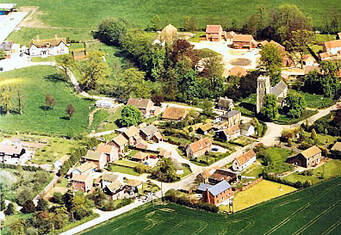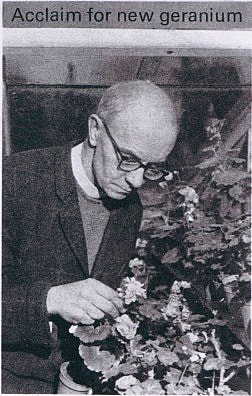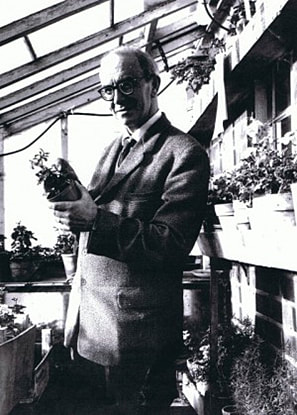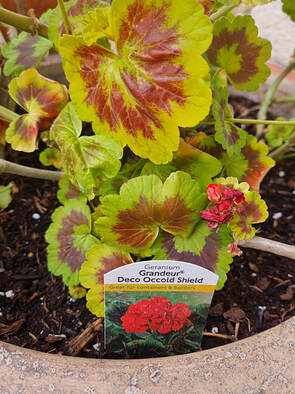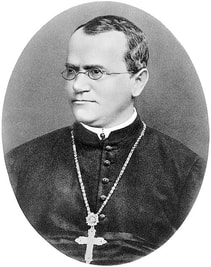"Deacons" the Rev. Stanley P. Stringer Story
|
The website of Occold, a village in Suffolk England, has kindly allowed the Society to reproduce this article.
Canon Stringer (1911-1986), as he is remembered in the horticultural world, was the former vicar of Occold. A number of us were aware that he produced garden geraniums (pelargoniums) but only a few of the village elders were aware of his major contribution to this field. I was amazed to find his name and pictures of plants (cultivars) on websites throughout Europe, North America and Australia. |
|
To find Canadians and Americans arguing about the correct naming of some of his cultivars and an Australian lady clearly trying to copy his most famous ‘Deacon' range was something of a shock. At least eighty [80] new pelargonium cultivars were developed in a greenhouse at The Vicarage.
Stanley P. Stringer was born in 1911 but his fame as a leading garden plant hybridist didn't begin until 1964 when his first pelargonium was introduced. Rev. Stringer was a Deacon when he bred them and due to this they were given the name Deacon. The first of his many miniatures had single (5 petal) salmon flowers and dark leaves and he named it ‘Alde'. This was followed by several double (10 petal) miniatures, including in 1966/7 a pelargonium with scarlet flowers and dark leaves named ‘Rigal', one with a pale violet-pink flowers with white centres named Denebola and an important miniature called ‘Orion' which was smothered in double orange flowers. |
|
Orion was important as a garden plant in its own right, but also because, when crossed with the ivy leafed pelargonium ‘Blue Peter', it became the basis of the renowned ‘Deacon' subgroup.
|
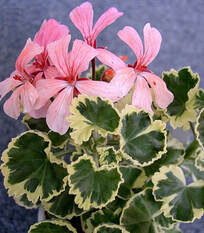 Golden Chalise Golden Chalise
The last Stringer cultivar was a miniature called Golden Chalice (sometimes called Sussex Chalice or Sussex Chance) and a few gardeners seem to think that he saved the best to last with its variegated foliage of olive green and cream with salmon flowers that are often spotted with scarlet.
It struck me, whilst researching his life and times, that Canon Stanley Stringer had a lot in common with the founder of genetics Czech Augustinian abbott Gregor Mendel (1822 - 1884). |
|
It appears that both were men of the cloth who shut out the problems of the world by immersing themselves in a seemingly endless quest involving incredibly complex and tortuous pursuit of perfection require in plant breeding. I gather that the Rev Stringers greenhouse was rarely a spectacle of blooms, ladies stockings were often required over the plants to stop unwanted pollination in this hybridising laboratory.
On one occasion he went to read his Sunday sermon to find out that he had brought his pelargonium list into church by mistake. Both men could appear to be intransigent, as they didn't compromise their principles easily; for the Rev Stringer it included his total opposition to all gambling. But neither was filled with a sense of self importance. When the Rev Stringer lost his nursery outlet he had to be persuaded by Fred Mepham that other nurseries were happy to take on his new introductions. And he is remembered kindly by former Occold School pupils for allowing them to play cricket on his lawn. Like his greenhouse his garden was clearly a means to a greater end rather than an end in itself. For both these clerical boffins the full acknowledgement of their considerable achievement came from abroad and largely after their life time. Deacon's are Pelargoniums with a common origin. Since they lack the characteristic features of the ivy geraniums, but have the typical leaves of the zonal geraniums, they have been placed in the variety zonals. All Deacon's are dwarfs - even though many of them grow much larger. Some of them even become finer and bloom more in larger pots. They are what you might call the Pelargonium equivalent of the Floribunda Rose; they flower very prolifically over a long time. Researched by Andy Andrews for the Boffins Fayre - with some additional material |
